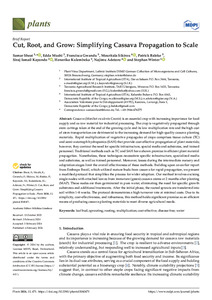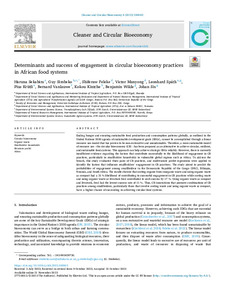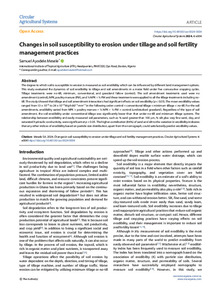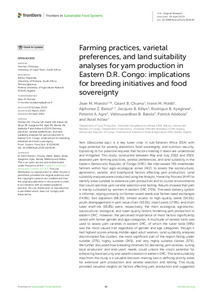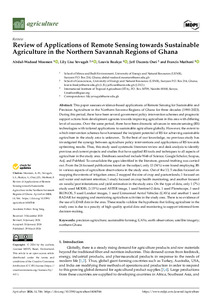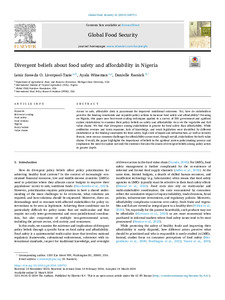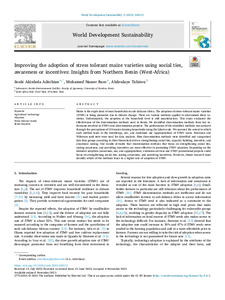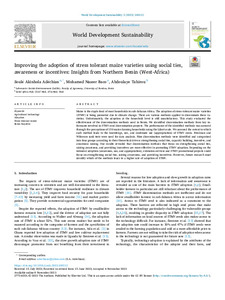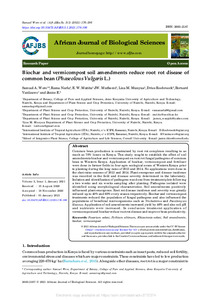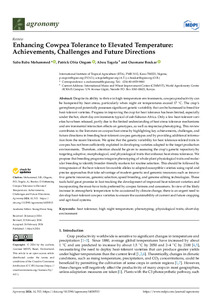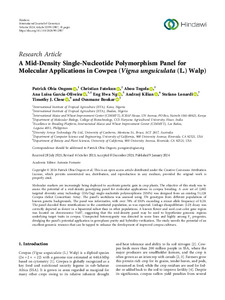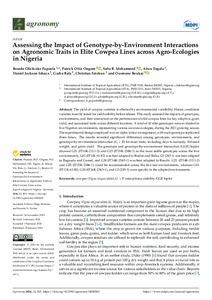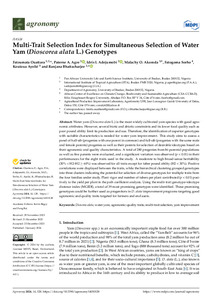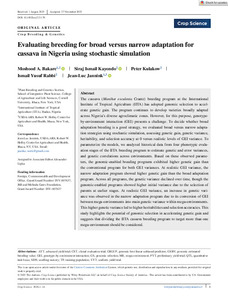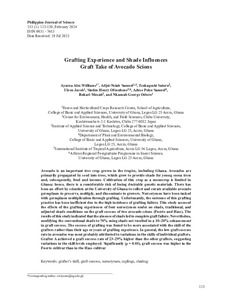Welcome to the International Institute of Tropical Agriculture Research Repository
Journal and Journal Articles: Recent submissions
Now showing items 141-160 of 5279
-
Cut, root, and grow: simplifying cassava propagation to scale
(2024-02-06)Cassava (Manihot esculenta Crantz) is an essential crop with increasing importance for food supply and as raw material for industrial processing. The crop is vegetatively propagated through stem cuttings taken at the end of the growing cycle and its low multiplication rate and the high cost of stem transportation are detrimental to the increasing demand for high-quality cassava planting materials. Rapid multiplication of vegetative propagules of crops comprises tissue culture (TC) and semi-autotroph ... -
Determinants and success of engagement in circular bioeconomy practices in African food systems
(2023-11-21)Ending hunger and ensuring sustainable food production and consumption patterns globally, as outlined in the United Nations 2030 agenda of sustainable development goals (SDGs), cannot be accomplished through a linear resource use model that has proven to be non-restorative and unsustainable. Therefore, a more sustainable model of resource use - the circular bioeconomy (CB) - has been proposed as an alternative to achieve circular, resilient, and sustainable food systems. This approach can help ... -
Changes in soil susceptibility to erosion under tillage and soil fertility management practices
(2024)The degree to which soil is susceptible to erosion is measured as soil erodibility which can be influenced by different land management options. This study evaluated the dynamics of soil erodibility to tillage and soil amendments in a maize field under five consecutive cropping cycles. Tillage treatments were no-till, minimum, conventional, and grassland fallow (control). The soil amendment treatments used were no amendment (control), NPK, poultry manure (PM), and ½ NPK+ ½ PM and these treatments ... -
Farming practices, varietal preferences, and land suitability analyses for yam production in Eastern D.R. Congo: implications for breeding initiatives and food sovereignty
(2024-03-29)Yam (Dioscorea spp.) is a key tuber crop in sub-Saharan Africa (SSA) with huge potential for poverty alleviation, food sovereignty, and nutrition security. Exploiting its full potential requires that factors holding it down are understood and mitigated. This study, conducted between May and July 2022 and 2023, assessed yam farming practices, varietal preferences, and land suitability in the Eastern Democratic Republic of Congo (DRC). We interviewed 765 smallholder farmers within four agro-ecological ... -
Review of Applications of Remote Sensing towards Sustainable Agriculture in the Northern Savannah Regions of Ghana
(2024-03-29)This paper assesses evidence-based applications of Remote Sensing for Sustainable and Precision Agriculture in the Northern Savanna Regions of Ghana for three decades (1990–2023). During this period, there have been several government policy intervention schemes and pragmatic support actions from development agencies towards improving agriculture in this area with differing level of success. Over the same period, there have been dramatic advances in remote sensing (RS) technologies with tailored ... -
Divergent beliefs about food safety and affordability in Nigeria
(2024-06)Access to safe, affordable diets is paramount for improved nutritional outcomes. Yet, how do stakeholders perceive the binding constraints and requisite policy actions to increase food safety and affordability? Focusing on Nigeria, this paper uses best-worst scaling techniques applied to a survey of 200 government and agrifood system stakeholders to examine their policy beliefs on safety and affordability vis-à-vis the vegetable and fish value chains. We find that divergence among stakeholders is ... -
Emerging ecological trends in West Africa: implications on soil organic matter and other soil quality indicators
(2024-03-09)Aims In West Africa, savannas are changing to either forest islands or arable lands arising from anthropogenic interference with the natural ecosystem. This study aimed at quantifying the trade-offs of this land use conversion on major soil quality indicators. Methods We evaluated soil organic matter (SOM) and other soil quality indicators such as macro- and micronutrients (including the absence of some hazardous trace metals) using standard methodologies across 11 settlements in Burkina ... -
Improving the adoption of stress tolerant maize varieties using social ties, awareness or incentives: Insights from Northern Benin (West-Africa)
(2023-11-08)Maize is the staple food of most households in sub-Saharan Africa. The adoption of stress-tolerant maize varieties (STMV) is being promoted due to climate change. There are various methods applied to disseminate these varieties. Unfortunately, the adoption at the household level is still unsatisfactory. This study evaluated the effectiveness of the dissemination methods used in Benin. We identified dissemination methods from key informants involved in STMV seed dissemination projects. The performance ... -
Improving the adoption of stress tolerant maize varieties using social ties, awareness or incentives: insights from Northern Benin (West-Africa)
(2023)Maize is the staple food of most households in sub-Saharan Africa. The adoption of stress-tolerant maize varieties (STMV) is being promoted due to climate change. There are various methods applied to disseminate these varieties. Unfortunately, the adoption at the household level is still unsatisfactory. This study evaluated the effectiveness of the dissemination methods used in Benin. We identified dissemination methods from key informants involved in STMV seed dissemination projects. The performance ... -
Biochar and vermicompost soil amendments reduce root rot disease of common bean (Phaseolous Vulgaris L.)
(2021-01)Common bean production is constrained by root rot complexes resulting to as much as 70% losses in Kenya. This study sought to establish the effect of soil amendments biochar and vermicompost on root rot fungal pathogens of commonbean in Western Kenya. Application of biochar, vermicompost and fertilizer were done in farmer fields in four agro ecological zones of Western Kenya prior to planting during the long rains of 2013 and 2014. No applications were done in the shot rains seasons of 2013 and ... -
Enhancing cowpea tolerance to elevated temperature: achievements, challenges and future directions
(2024-03-01)Despite its ability to thrive in high-temperature environments, cowpea productivity can be hampered by heat stress, particularly when night air temperatures exceed 17 °C. The crop’s germplasm pool potentially possesses significant genetic variability that can be harnessed to breed for heat-tolerant varieties. Progress in improving the crop for heat tolerance has been limited, especially under the hot, short-day environments typical of sub-Saharan Africa. Only a few heat-tolerant varieties have ... -
A mid-density single-nucleotide polymorphism panel for molecular applications in cowpea (Vigna unguiculata (L.) Walp)
(2024-01-01)Molecular markers are increasingly being deployed to accelerate genetic gain in crop plants. The objective of this study was to assess the potential of a mid-density genotyping panel for molecular applications in cowpea breeding. A core set of 2,602 targeted diversity array technology (DArTag) single-nucleotide polymorphisms (SNPs) was designed from an existing 51,128 Cowpea iSelect Consortium Array. The panel’s usefulness was assessed using 376 genotypes from different populations of known genetic ... -
Assessing the impact of genotype-by-environment interactions on agronomic traits in elite cowpea lines across agro-ecologies in Nigeria
(2024)The yield of cowpea varieties is affected by environmental variability. Hence, candidate varieties must be tested for yield stability before release. This study assessed the impacts of genotypes, environments, and their interaction on the performance of elite cowpea lines for key adaptive, grain yield, and associated traits across different locations. A total of 42 elite genotypes were evaluated in five Nigerian environments, representing various savanna ecologies, during the 2021 growing season. ... -
Multi-trait selection index for simultaneous selection of water yam (Dioscorea alata L.) genotypes
(2024-01-03)Water yam (Dioscorea alata L.) is the most widely cultivated yam species with good agronomic attributes. However, several biotic and abiotic constraints and its lower food quality such as poor pound ability limit its production and use. Therefore, the identification of superior genotypes with suitable characteristics is needed for water yam improvement. This study aims to assess a panel of half-sib (progenies with one parent in common) and full-sib (progenies with the same male and female parents) ... -
Selection of extra-early white quality protein maize (Zea mays L.) inbred lines for drought and low soil nitrogen resilient hybrid production
(2024-01-30)In West and Central Africa (WCA), drought and low soil nitrogen (low N) impede increased maize (Zea mays L.) productivity and production. Due to climate change, the two stresses usually occur together, leading to food, nutritional, and economic insecurity in the sub-region. There is, therefore, the need for the development and availability of high-yielding extra-early maturing white Quality Protein Maize (QPM) synthetics and hybrids with resilience to the prevailing stresses through the identification ... -
Misattribution prevents learning
(2024)In many markets, consumers believe things about products that are not true. We study how incorrect beliefs about product quality can persist even after a consumer has used a product many times. We explore the example of fertilizer in East Africa. Farmers believe much local fertilizer is counterfeit or adulterated; however, multiple studies have established that nearly all fertilizer in the area is good quality. We develop a learning model to explain how these incorrect beliefs persist. We show ... -
A new multivariate agricultural drought composite index based on random forest algorithm and remote sensing data developed for Sahelian agrosystems
(2023-06-16)This manuscript aims to develop a new multivariate composite index for monitoring agricultural drought. To achieve this, the AVHRR, VIIRS, CHIRPS data series over a period of 40 years, rainfall and crop yield data as references were used. Variables include parameters for vegetative stress (SVCI, PV, SMN), water stress (PCI, RDI, NRDI), and heat stress (SMT, TCI, STCI), and a new variable related to environmental conditions was calculated through a normalized rainfall efficiency index. Then, random ... -
Evaluating breeding for broad versus narrow adaptation for cassava in Nigeria using stochastic simulation
(2024)The cassava (Manihot esculenta Crantz) breeding program at the International Institute of Tropical Agriculture (IITA) has adopted genomic selection to accelerate genetic gain. The program continues to develop varieties broadly adapted across Nigeria’s diverse agroclimatic zones. However, genotype by- environment interaction (GEI) presents a challenge for this purpose. To decide whether broad adaptation breeding is a good strategy, we evaluated broad versus narrow adaptation strategies using ... -
Grafting experience and shade influences graft take of avocado scions
(2024-02)Avocado is an important tree crop grown in the tropics, including Ghana. Avocados are primarily propagated by seed into trees, which grow to provide shade for young cocoa trees and, subsequently, food and income. Cultivation of this crop as a monocrop is limited in Ghana; hence, there is a considerable risk of losing desirable genetic materials. There has been an effort by scientists at the University of Ghana to collect and curate available avocado germplasm to preserve, multiply, and disseminate ...

